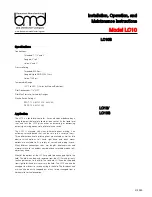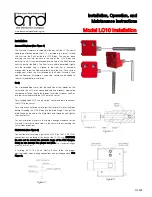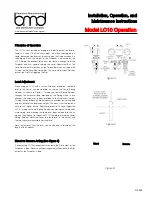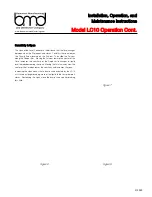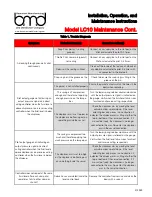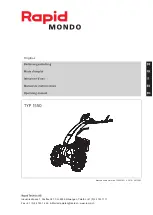
1/2019
Installation, Operation, and
Maintenance Instructions
www.beaumontmanufacturing.com
Model LC10 Operation
Principles of Operation
The LC10 uses Archimedes' principle in order to detect the level of
liquid in a vessel. The Displacer weighs less when submerged in a
liquid, because of the buoyant force acting on the Displacer when it is
submerged. Since the weight of the Displacer is balanced by the
LC10 Spring, the buoyant force from the liquid is enough to lift the
Displacer and Arm upward rotating the Level Adjustment Bar. The
Level Adjustment Bar pushes on the Torque Bar which acts upon the
Fulcrum on the Level Adjustment Bar. The Level Adjustment Bar then
pushes the Pilot Pin triggering the Pilot.
Level Adjustment
When using an LC10 with a vertical Displacer orientation, the liquid
level in the vessel can be adjusted by turning the Lower Spring
Retainer as shown in Figure 4. Turning the Lower Spring Retainer
changes the amount of load provided by the Spring which in turn
changes the amount of support provided to the Displacer’s weight.
Turning the Lower Spring Retainer clockwise provides less spring load
and less offset of the displacers weight. This means that the liquid will
have to rise higher on the Displacer in order to lift it and trigger the
LC10. Turning the Lower Spring Retainer counter
-
clockwise provides
more spring load meaning the liquid level does not need to rise as
high on the Displacer to trigger the LC10. Therefore turning the Lower
Spring Retainer clockwise raises the liquid level in the vessel, and
turning it counter
-
clockwise lowers the level.
Note that amount that the level can be adjusted is limited by the
length of the Displacer.
Direct vs Reverse Acting (See Figure 6)
A direct acting LC10 arrangement will increase the Pilot output as the
Displacer is lifted. Reverse acting arrangement will decrease the Pilot
output as the Displacer is lifted.
Figure 4
Figure 5
Reverse
Direct
Figure 6

